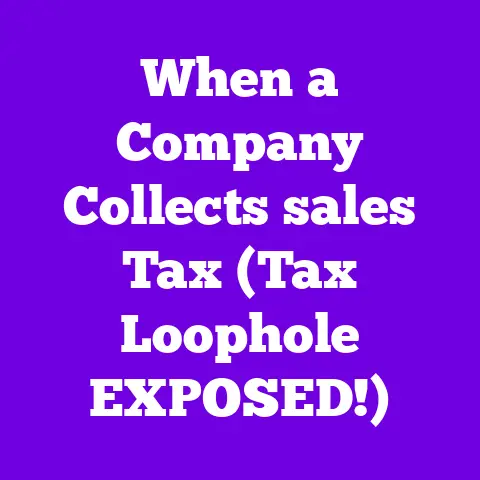How sales Tax Works on Car Trade-Ins (Don’t Overpay!)
The thrill of driving a new car is undeniable.
But before you get caught up in the shiny exterior and that new car smell, there’s a crucial financial aspect to consider: sales tax, especially when you’re trading in your old vehicle.
Many people focus solely on the sticker price and monthly payments, overlooking how sales tax on a trade-in can significantly impact the total cost.
In this article, I’ll break down how sales tax works on car trade-ins in 2025, arming you with the knowledge to avoid overpaying and make informed decisions.
Understanding Sales Tax
Sales tax is a consumption tax levied by state and local governments on the sale of goods and services.
When you purchase a vehicle, sales tax is typically calculated as a percentage of the purchase price.
This percentage varies considerably depending on where you live.
- Definition: Sales tax is a percentage of the sale price that’s added to the cost of goods or services.
It’s collected by the seller and remitted to the government. - Rate Variation: Sales tax rates differ drastically across the United States.
As of 2024, states like Delaware, Montana, New Hampshire, Oregon, and Alaska have no state sales tax.
On the other hand, states like California, Tennessee, and Louisiana have some of the highest combined state and local sales tax rates.
For example, California’s state sales tax rate is 7.25%, but when you include local sales taxes, the combined rate can exceed 10% in some cities.
(Source: Tax Foundation) - New vs.
Used Cars: Generally, sales tax is applied to both new and used car purchases.
The tax is based on the final selling price, regardless of whether the car is fresh off the assembly line or has had previous owners.
Example: If you buy a car for $30,000 in a state with a 6% sales tax, you’ll pay an additional $1,800 in sales tax ($30,000 x 0.06 = $1,800), bringing the total cost to $31,800.
The Mechanics of Car Trade-Ins
Trading in your car is a common way to offset the cost of a new vehicle.
The dealership assesses the value of your current car and offers you a credit towards the purchase of the new one.
However, understanding the process is crucial for getting a fair deal.
- The Trade-In Process: The dealer will inspect your car, considering factors like its age, mileage, condition, and market demand.
They’ll then offer you a trade-in value, which is deducted from the price of the new car you’re buying. - Knowing Your Car’s Value: Before you even step foot in a dealership, it’s essential to know the market value of your car.
This knowledge empowers you to negotiate effectively and ensures you’re not lowballed. - Evaluating Resale Value: Several online tools can help you determine your car’s trade-in value.
Sites like Kelley Blue Book (https://www.kbb.com/) and Edmunds (https://www.edmunds.com/) provide estimated values based on your car’s specifics.
These tools consider factors like the car’s make, model, year, mileage, condition, and optional features.
Example: Let’s say Kelley Blue Book estimates your car is worth $8,000 in “Good” condition.
If the dealer offers you only $6,000, you know you have room to negotiate.
How Sales Tax is Calculated on Trade-Ins
The real magic happens when you understand how your trade-in affects the sales tax you pay.
In many states, the value of your trade-in is deducted from the price of the new car before sales tax is calculated.
This can result in significant savings.
- Trade-In Value Reduces Taxable Amount: In states with this “trade-in credit,” you only pay sales tax on the difference between the price of the new car and the value of your trade-in.
Illustrative Examples: Let’s consider two scenarios:
- Scenario 1 (State with Trade-In Credit): You’re buying a new car for $35,000 and trading in your old car for $10,000.
The taxable amount is $25,000 ($35,000 – $10,000).
If the sales tax rate is 6%, you’ll pay $1,500 in sales tax ($25,000 x 0.06). - Scenario 2 (State with NO Trade-In Credit): You’re buying a new car for $35,000 and trading in your old car for $10,000.
However, in this state, there’s no trade-in credit for sales tax purposes.
You’ll pay sales tax on the full $35,000.
At a 6% rate, that’s $2,100 in sales tax ($35,000 x 0.06).
As you can see, the difference is substantial ($600 in this case)!
- Scenario 1 (State with Trade-In Credit): You’re buying a new car for $35,000 and trading in your old car for $10,000.
Common Misconceptions: One common misconception is that all states treat trade-ins the same way.
Another is confusion between net and gross sales tax calculations.
Net sales tax is calculated after the trade-in value is deducted, while gross sales tax is calculated on the full purchase price.
State-Specific Sales Tax Regulations
Understanding state-specific rules is paramount.
Each state has its own unique approach to sales tax and trade-ins.
- Varying State Approaches: Some states offer a full trade-in credit, meaning the entire value of your trade-in is deducted from the taxable amount.
Others offer a partial credit, while some offer no credit at all. - Favorable States: States like California, Texas, and Florida offer trade-in credits, potentially saving you hundreds or even thousands of dollars.
- Recent Legislative Changes for 2025: It’s crucial to stay updated on any legislative changes affecting sales tax and trade-ins.
State tax laws are subject to change, so what was true in 2024 might not be the case in 2025.
I recommend checking your state’s Department of Revenue website for the most current information.
Table of Selected State Sales Tax and Trade-In Policies (Example):
Note: Sales tax rates and policies are subject to change.
This table provides a general overview and should not be considered legal or financial advice.
Always verify information with official sources.
Common Pitfalls and How to Avoid Overpaying
Many consumers make mistakes during the trade-in process that lead to overpaying on sales tax.
Here are some common pitfalls and how to avoid them:
- Not Negotiating: One of the biggest mistakes is accepting the dealer’s first offer without negotiating.
Always negotiate both the price of the new car and the value of your trade-in.
Remember, dealers often inflate the price of the new car to offset a seemingly generous trade-in offer. - Misunderstanding Sales Tax Implications: Failing to understand how your state handles sales tax on trade-ins can be costly.
Educate yourself on your state’s specific rules before you start negotiating. - Not Keeping Records: Maintain thorough records of all transactions, including the purchase agreement, trade-in appraisal, and sales tax calculations.
This documentation is essential if you need to dispute any charges later. -
Actionable Steps:
- Research: Use online tools to determine your car’s market value.
- Negotiate: Don’t be afraid to negotiate both the price of the new car and the trade-in value.
- Understand: Know your state’s sales tax laws regarding trade-ins.
- Document: Keep detailed records of all transactions.
Conclusion
Navigating the world of car trade-ins and sales tax can seem daunting, but with a little knowledge, you can save a significant amount of money.
By understanding how sales tax works in your state, knowing the value of your trade-in, and negotiating effectively, you can drive off the lot feeling confident that you got the best possible deal.
Remember, being an informed consumer is the best way to protect your financial interests and avoid overpaying in 2025.






